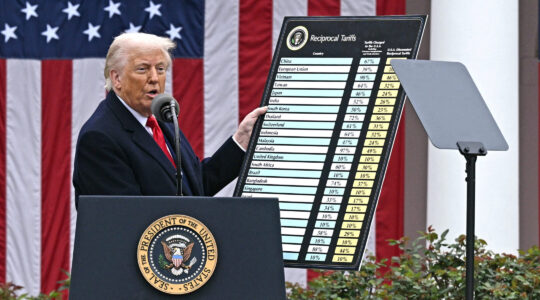NEW YORK (JTA) – Judy Bart Kancigor is one of the rare Cinderella stories in publishing, beating the odds to earn a contract without contacts in the industry.
It all started with a spiral-bound volume of family recipes that would become ”Cooking Jewish: 532 Great Recipes from the Rabinowitz Family” (Workman Publishing, 2007).
In 1996, Kancigor was a court reporter and about to become a grandmother when some aunts on her maternal grandmother’s side of the family were declining.
“As Aunt Estelle’s condition worsened, Aunt Sally was moving into assisted living,” Kancigor recalls. “Aunt Hilda was on dialysis, and Aunt Irene didn’t know who I was when I called.” She pauses.
“That’s when it hit me – one generation was leaving while another one was coming. How would my grandchild know about the Rabinowitz family?”
Alarmed by this prospect, she wanted to give the baby a gift – the past on a plate.
“I wished I could reach my arms across the generations and somehow pass on a taste of the legacy that had been bequeathed to me,” Kancigor says. “I decided to become a conduit. But I wondered what I wanted to impart besides Aunt Sally’s apple cake and Aunt Irene’s kugel. I wanted the next generation to know the stories, to know where we came from, to know our history.”
It was a history seasoned with tantalizing foods. Cooking and eating were staples of Rabinowitz life.
Kancigor’s maternal grandparents, Hinda and Harry Rabinowitz, had immigrated to New York City from Belarus, Russia, in 1907. In Belle Harbor, Queens, they raised seven children on shtetl fare, notably kishke and kreplach. Free from Cossack terror, they hoped their children would receive an education and succeed.
Their children thrived on foods Mama Hinda measured with a yahrzeit glass. They spoke English, fulfilled their parents’ dreams and never heard the hoofbeats of Cossack horses.
Kancigor’s mother and aunts carried the torch, cooking Old World favorites in their modern kitchens. They relied on Mama Hinda’s handfuls of a little of this and that to make black bread, potatoes and chicken soup as they simultaneously embraced Jell-O and sliced white bread, clipping trendy recipes from women’s magazines.
Kancigor grew up in a two-family house downstairs from her grandparents. Her favorite pastime was sitting on the front porch glider and listening to family stories. Like a piece of sponge cake, she soaked up anecdotes – Mama Hinda’s cooking, too.
Her delicious memories became the motivation for preserving the family’s legacy.
Early in the process, Kancigor enrolled in a cookbook writing seminar at UCLA. The teacher, cookbook author Norman Kolpas, asked students to describe their projects.
Among chefs, food writers and caterers, Kancigor was intimidated.
“Oh, I’m just writing a family cookbook,” she mumbled.
Kolpas grew serious and pointed a finger at her.
“What you’re doing is very important,” she said. “Don’t let anyone stop you.”
Kancigor contacted relatives as she assembled an album of family recipes, stories and photos. Taking a huge gamble, she printed 500 copies of “Melting Pot Memories.” While her husband feared these spiral bound books would forever clutter their garage, she handed out copies at a nephew’s bar mitzvah.
With minimal publicity, word spread about this self-published book. “Melting Pot Memories” sold faster than honey cakes at Rosh Hashanah – sales reached 11,000 copies. Its overwhelming success landed her a book contract from Workman Press to write an expanded version, which became the recently published “Cooking Jewish.”
Along the way, Kancigor’s son asked, “Why are people reading about our family?”
The simple answer: They are hungry for their forgotten past. In essence, the Rabinowitzes are every American Jewish family.
“Although the Rabinowitz family is Ashkenazi, I wanted Sephardic dishes in my cookbook, too,” Kancigor says. “If anyone had married into a Sephardic family, I was dying to include their foods.”
She sought tales and recipes from relatives as far flung as in-laws of in-laws. The result is a nostalgic step back in time.
“Every Friday, my grandmother baked challah,” Kancigor says. “My brother Gary and I could smell it wafting from upstairs.”
At Rosh Hashanah, they would break off chunks and dip them in honey for a sweet New Year. Decades later in 1976, when Kancigor heard her grandmother was in intensive care, she was compelled to get the recipe for a challah that was as light as a cloud.
From her deathbed, 91-year-old Mama Hinda dictated its ingredients and instructions to Kancigor’s mother, who wrote it down. The recipe would be set aside for years.
Assembling her cookbook, Kancigor tried the recipe. The results were disappointing.
“In her condition, perhaps Mama Hinda forgot to mention certain crucial things,” she says.
Devastated, Kancigor took the recipe scribbled on scrap paper to a professional baker, who miraculously re-created the challah’s exact taste.
“I had a Madeleine moment when I took my first bite,” says Kancigor, admitting that the baker took a different route to arrive at the same place.
Since then Kancigor’s first grandchild was born; three more have followed.
“They never knew Mama Hinda but they’ve eaten her challah,” she says. “It’s tying the generations together.
“The thing I’m most proud of – even more than publishing a book – is collecting our family stories and recipes.”
Jewish history is ongoing, she explains.
“By knowing where you came from, you can see what part your family played in it, whether it be from the Lower East Side to the suburbs, from the Holocaust to Los Angeles, or from peddler to investment banker,” she says.
Kancigor is gratified that readers respond to her relatives as if they were characters in a novel. She encourages everyone to write a memoir cookbook.
“This Rosh Hashanah, you and your children are blazing into the 21st century with honey cake and challah, carrot kugel and sweet wine,” she says.
The Jewish New Year is a time to contemplate the past while considering the future, a time to dig out old recipes, a time when cooking Jewish is cherished. But for those who’ve lost their grandparents’ recipes, open Kancigor’s cookbook and prepare a Rabinowitz favorite.
After all, they’re family.
The following recipes are from “Cooking Jewish”:
MAMA HINDA’S CHALLAH
(Adapted from Hinda Rabinowitz)
No Jewish food reminds Kancigor of her grandmother more than Mama Hinda’s challah. With a Litvak sensibility, Mama could live without sweets. But once a year, at Rosh Hashanah, she sprinkled raisins into her challah dough to enhance its sweetness.
Ingredients:
3 1/2 cups bread flour
1/2 cup warm water (100 to 110 degrees)
2 3/4 teaspoons active dry yeast
1 teaspoon, plus 1/4 cup, sugar
2 large eggs, at room temperature
1/4 cup vegetable oil, plus extra for oiling the bowl
1 1/2 teaspoons kosher (coarse) salt
1/3 cup raisins (optional)
Vegetable oil, vegetable cooking spray or parchment paper for greasing baking sheet
Egg wash: 1 egg yolk mixed with 1 tablespoon water
Preparation:
1. Set aside 2 tablespoons of the flour. Place the remaining flour in the large bowl of an electric mixer, fitted with a flat paddle or dough hook. Make a well in the center of the flour and pour in 1/4 cup of the warm water. Sprinkle the yeast over the water and add 1 teaspoon of the sugar. Using a fork, stir the water, yeast, and sugar together gently, keeping the mixture in the well. (Don’t worry if a little flour becomes incorporated.) Let stand until bubbly, about 10 minutes.
2. In a separate bowl, beat the eggs, the 1/4 cup oil, the remaining 1/4 cup sugar, and the salt together with a fork. Add the egg mixture and the remaining 1/4 cup warm water to the flour mixture, and beat on low speed until incorporated. Then beat on medium speed until smooth and silky, 5 to 10 minutes. (The dough should feel slightly sticky and, to quote “Adventures in Jewish Cooking,” by Jeffrey Nathan, “like a baby’s tush.”) If it is too sticky, add the reserved 2 tablespoons of flour (or more, if necessary), 1 tablespoon at a time and continue to mix for a few more minutes.
3. Oil a large bowl and place the ball of dough in it, turning the dough so it is oiled all over. Cover with a kitchen towel and set aside in a warm place until the dough has almost doubled in bulk, at least 1 hour. (A warm place would be an oven preheated to the lowest setting and then turned off.)
4. When the dough has almost doubled, punch it down and knead it by hand for 1 to 2 minutes, incorporating the raisins, if using.
5. For a spiral Rosh Hashanah challah, roll the dough into a single rope about 34 inches long. Beginning at one end, wind the rope from the center of the spiral outward, keeping the center slightly elevated, like a turban. Tuck the end under.
6. Lightly grease a baking sheet, or better yet, line it with parchment paper. Place the shaped dough on the prepared baking sheet, cover it with a slightly dampened cloth, and allow it to rise in a warm place for 1 hour.
7. Preheat oven to 375 degrees.
8. Brush the top of the loaf with the egg wash. Bake until the top is brown and the bottom sounds hollow when tapped with your fingers, 25 to 30 minutes.
9. Transfer to a wire rack and let cool completely.
Yield: 1 1/2-pound round challah
GERMAN PLUM CAKE
(From Herta Heidingsfelder)
Herta Heidingsfelder is the mother-in-law of one of Kancigor’s cousins. Herta learned to make this traditional Rosh Hashanah cake – really a tart with a cookie crust – from her mother-in-law. At 90, she still bakes this dessert for the New Year.
Ingredients:
8 tablespoons (1 stick) unsalted butter, at room temperature, plus extra for greasing the pie plate (Margarine can be substituted for the butter.)
1/2 cup, plus 2 tablespoons, sugar
Yolk of 1 large egg, at room temperature
1 cup all-purpose flour, plus 1 to 3 tablespoons, if needed
2 to 2 1/4 pounds fresh Italian plums, halved and pitted
Preparation:
1. Preheat oven to 350 degrees. Butter a 9-inch pie plate, or the bottom and 1 inch up the sides of a 9-inch springform pan.
2. Be sure the butter and egg yolk are at room temperature. Combine the butter, the 1/2 cup sugar and the egg yolk in a bowl and mix by hand, until thoroughly combined. Gradually add the 1 cup flour. If it is too sticky, add the extra flour, 1 tablespoon at a time. Press the dough into the bottom and barely up the rim of the prepared pie plate, or over the bottom and 1 inch up the sides of the springform pan.
3. Cut 2 slits in each plum half, slicing it two-thirds of the way down, so it fans out into 3 sections. Stand the plums upright in the pie plate, packed tightly in circles with the skin facing out and the uncut ends pressed into the dough. There should be very little dough exposed. Bake until the dough is lightly browned, about 45 minutes. The tart will seem juicy when it comes from the oven. Let the tart cool on a wire rack.
4. If you will be serving the tart the same day, store it at room temperature. Otherwise store it, covered with plastic wrap, in the refrigerator for up to 2 days. Allow it to come to room temperature before serving.
5. If a springform is used, remove the sides before serving.
6. Immediately before serving, sprinkle the remaining 2 tablespoons sugar over the fruit.
Yield: 6-8 servings
ROSH HASHANAH HONEY COOKIES
(By Ruchi Padwa)
From Antwerp, Belgium, Ruchi Padwa is a distant cousin of Kancigor’s husband, Barry. The mother of 12, Ruchi bakes 40 dozen of these cookies every Rosh Hashanah in between sewing her children’s holiday clothes by hand. Amazingly, the cousins found each other on the Internet.
Ingredients:
2 large eggs
1/3 cup honey
1 cup sugar
2/3 cup vegetable oil, plus extra for oiling hands
1 1/2 teaspoons pure vanilla extract
1/2 teaspoon baking powder
1/2 teaspoon ground cinnamon
2 tablespoons seltzer or club soda
4 1/4 cups all-purpose flour
Parchment paper
Preparation:
1. Fit an electric mixer with the dough hook and beat the eggs, honey, sugar, oil, vanilla, baking powder, cinnamon and seltzer on medium-low speed for 15 minutes. Add the flour and mix until incorporated. Cover the bowl and refrigerate for several hours, or as long as overnight.
2. Preheat the oven to 350 degrees. Line several cookie sheets with parchment paper.
3. With oiled hands, form the dough into walnut-size balls. Place them 1 inch apart on the prepared baking sheets. Place 2 oven racks on the bottom third and top third of the oven. Bake 2 cookie sheets at a time, rotating the sheets from top to bottom and front to back, halfway through the baking. Bake until golden brown, 14 to 17 minutes. (Watch that the bottoms don’t burn.)
4. Let cookies cool on the cookie sheets set on wire racks.
5. Repeat with the remaining dough. Cookies freeze well.
Yield: About 8 dozen
CANDY SALAMI
(By Libby Gordon)
When sliced, this candy resembles salami. The cocoa creates dark shading, while its nuts imitate light flecks. Kancigor’s cousin Libby Gordon once served this candy on a milchig (dairy) plate as a joke to scare Mama Hinda, who kept kosher. Sweetened with honey, it’s a treat at Rosh Hashanah.
Ingredients:
8 ounces walnut halves, half finely chopped and half left whole
1 cup honey
1/2 cup plain dry bread crumbs, plus more for dusting
2 teaspoons unsweetened cocoa powder
Preparation:
1. Combine the walnuts, honey and 1/2 cup bread crumbs in a medium-size (preferably nonstick) saucepan and bring to a boil over medium heat. Reduce the heat to a simmer and cook, stirring often with a wooden spoon for about 7 minutes, until the mixture is quite thick, clings together and leaves the sides of the pan. Stir in the cocoa powder; mixture resembles goo.
2. Spread the additional bread crumbs over a metal baking pan. Dump the honey goo onto the pan and set it aside to cool slightly. As soon as it is cool enough to handle (but still warm), roll it in the bread crumbs and shape it into a log about 11 inches long with tapered ends, in the shape of a salami. Roll it tightly in plastic wrap, cover it with aluminum foil and refrigerate until firm, about 2 hours.
3. To serve, use a serrated knife to cut the “salami” into 3/8-inch thick slices.
Yield: About 2 dozen slices
JTA has documented Jewish history in real-time for over a century. Keep our journalism strong by joining us in supporting independent, award-winning reporting.





